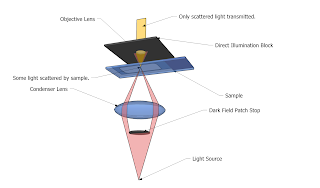1. Simple Microscopes: These were the microscopes in which Leeuwenhoek first reported his observations of microoraganisms. This contains a a single magnifying lens that was capable of approximately 300x magnification and acheived excellent clarity.
2. Uses a series of lenses for magnification. These microscopes replaced the simple microsope in modern laboratories.
Dark-Field Microscopes: These microscopes utilize a dark-field stop in the condenser that prevents light from directly entering the objectiev lens. Instead, light rays are reflected inside the condenser so that they pass into the slide at such an oblique angle that they miss the objective lens. Only those light rays that are scattered by the specimen enter the objective lens and are seen, so the specimen appears light against a dark background.
Phase Microscopes: These microscopes are utilized by scientists to examine living microorganisms or specimens that would be damaged or altered by attaching them to slides or staining them. Basically, these microscopes treat one set of light rays differently from another set of light rays.
The working principle
Confocal Microscopes: These microscopes use fluorescent dyes or fluorescent antibodies, but these microscopes use ultraviolet lasers to illuminate the fluorescent chemicals in only a single plane; the rest of the specimen remains dark and out of focus.




No comments:
Post a Comment